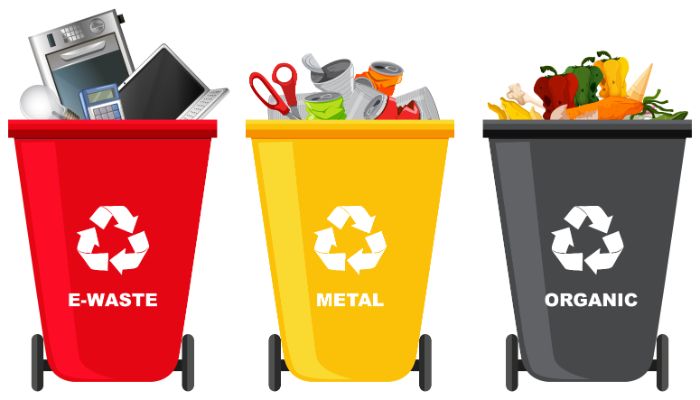In today’s technology-driven world, it’s no secret that electronic devices have become an integral part of our daily lives. From smartphones to laptops, from televisions to gaming consoles, we rely heavily on these gadgets for communication, work, entertainment, and so much more.
But what happens when these devices reach the end of their life cycle? Unfortunately, many people simply toss them into the trash without considering the environmental impact or potential harm they may cause. That’s where responsible e-waste management comes in. By taking a few simple steps, you can ensure that your electronic waste is handled in a safe and eco-friendly manner.
So let’s dive right in and explore how we can all contribute towards handling electronic trash safely and responsibly!
What is electronic trash?
Electronic trash, also known as e-waste, refers to any discarded electronic devices or equipment. This can include everything from old cell phones and computers to televisions and kitchen appliances. As technology continues to advance at a rapid pace, the amount of electronic waste being generated is skyrocketing.
What makes electronic trash particularly concerning is that it contains hazardous materials such as lead, mercury, and cadmium. These substances can be harmful not only to human health but also to the environment if not properly disposed of. When e-waste ends up in landfills or incinerators, these toxic chemicals can seep into the soil and water sources, causing pollution.
Interestingly enough, many people aren’t aware that electronic devices actually contain valuable resources like gold and silver. By recycling or repurposing them instead of throwing them away, we can recover these precious metals while reducing the demand for mining new raw materials.
Properly managing electronic trash involves more than just tossing it in the recycling bin. Different types of electronics require different methods of disposal due to their complexity and potentially hazardous components. It’s important to research local regulations regarding e-waste disposal options available in your area.
By handling electronic waste responsibly through proper recycling channels or donating still-functional devices for reuse, we can reduce environmental pollution and contribute towards conserving natural resources. So let’s all do our part by taking steps towards responsible e-waste management!
Types of electronic waste
When it comes to electronic waste, there are various types that can be found in our homes and workplaces. Understanding these different types is crucial for handling them safely and responsibly.
1. Computers and Laptops: With technology constantly advancing, many people replace their computers and laptops frequently. These devices contain hazardous materials like lead, mercury, and cadmium which need proper disposal.
2. Mobile Phones: Almost everyone owns a mobile phone nowadays, but what happens when we upgrade? Old phones often end up discarded or forgotten in drawers. They contain valuable metals like gold and silver which can be recycled.
3. Televisions: The shift from analog to digital television has left many old televisions obsolete. These bulky devices contain harmful substances such as phosphorous coatings on the screen glass.
4. Batteries: Whether they are single-use alkaline batteries or rechargeable lithium-ion batteries, they should never be thrown into regular trash bins due to their chemical composition.
5. Appliances: From refrigerators to microwaves, appliances also contribute significantly to electronic waste due to constant upgrades or breakdowns.
By familiarizing ourselves with the different types of electronic waste, we become more aware of the potential dangers they pose if not handled properly. It’s essential to seek out recycling programs or e-waste collection centers that ensure responsible disposal for a safer environment for all living beings on this planet.
How to handle electronic waste safely and responsibly
Electronic waste, also known as e-waste, is a growing concern in today’s digital age. With the rapid advancement of technology, our devices become outdated quickly, leading to an increase in electronic trash. It is crucial to handle this waste safely and responsibly to minimize its impact on the environment and human health.
One of the best ways to manage electronic waste is by recycling it properly. Many countries have designated collection centers or recycling programs specifically for e-waste. These centers ensure that valuable materials are extracted from old electronics while hazardous substances are disposed of correctly.
Another important aspect of responsible e-waste handling is data security. Before disposing of any device, it’s essential to remove all personal information stored within it. This can be done through factory resets or using specialized software designed for secure data erasure.
Furthermore, donating or selling working electronics can be a great way to extend their lifespan and reduce waste generation. Many organizations accept used devices and refurbish them for those in need. Alternatively, online marketplaces provide platforms where individuals can sell their old gadgets at affordable prices.
When purchasing new electronics, consider products with eco-friendly certifications such as Energy Star or EPEAT labels. These certifications ensure that the product meets certain energy efficiency standards and has less harmful environmental impacts during its manufacturing process.
Conclusion
In this digital age, our dependence on electronic devices is undeniable. However, with the rapid advancement of technology comes a growing concern – what happens to all the electronic trash we generate? It is crucial that we handle electronic waste safely and responsibly to protect our environment and human health.

 How to Choose the Right Window Replacement Contractor
How to Choose the Right Window Replacement Contractor  The Best Aircon servicing Singapore Maintaining Coolness by Performing Top-Quality Maintenance
The Best Aircon servicing Singapore Maintaining Coolness by Performing Top-Quality Maintenance  Why Columbus Homeowners Are Falling in Love with Epoxy Garage Floor Coatings
Why Columbus Homeowners Are Falling in Love with Epoxy Garage Floor Coatings  Flood Cleaning Services in Fort Worth, TX: Essential Steps to Restore Your Home
Flood Cleaning Services in Fort Worth, TX: Essential Steps to Restore Your Home  The Benefits of Caesarstone Quartz: Style, Strength, and Sustainability
The Benefits of Caesarstone Quartz: Style, Strength, and Sustainability  Are Home Elevators Worth the Investment? A Canadian Homeowner’s Guide
Are Home Elevators Worth the Investment? A Canadian Homeowner’s Guide  5 Common Gutter Problems That Gutter Guards Can Solve
5 Common Gutter Problems That Gutter Guards Can Solve  How a Whole-House Humidifier Can Help With Your Health
How a Whole-House Humidifier Can Help With Your Health  Master Bathroom Remodeling: Essential Tips for a Stylish Upgrade
Master Bathroom Remodeling: Essential Tips for a Stylish Upgrade 